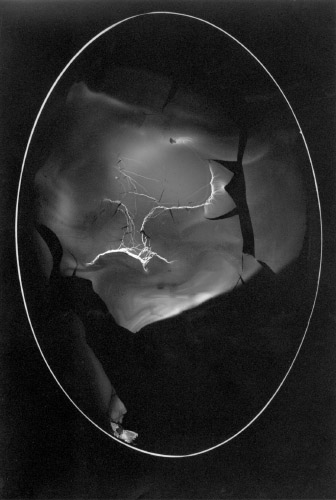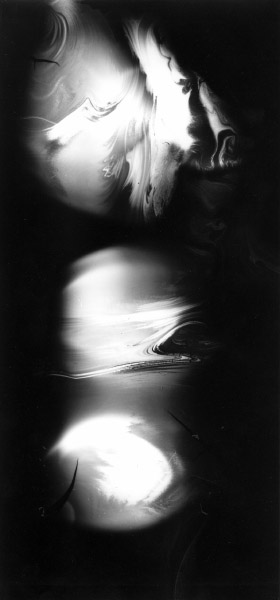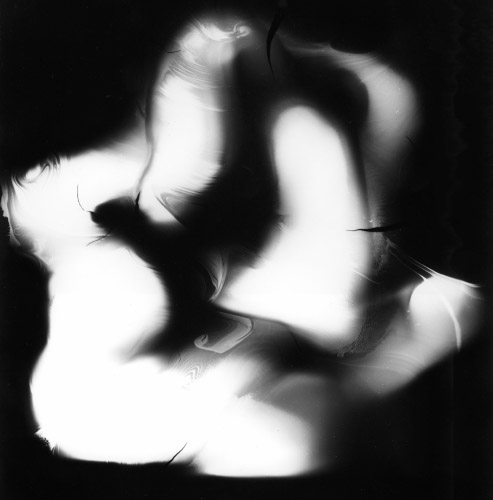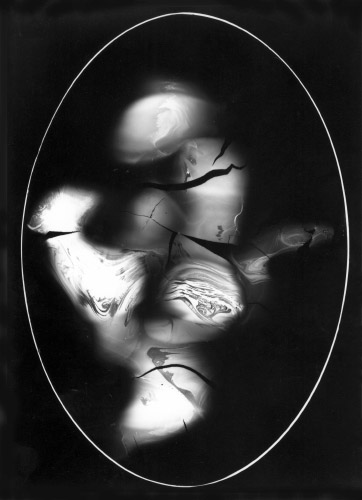
JERZY WROŃSKI - SOOTOGRAMS
9 - 30 IV 1999


During the first phase of my sootogram experiences in the 1980s (when I called them metamorphic photograms) I was so mesmerised by the possibility of revealing worlds hitherto unknown to me that I concentrated mainly on the technical side of creative processes, conducting various experiments and trying to penetrate the circumstances and conditions which allowed those processes to take the optimum course. I was also deeply convinced that an optimum course could give complete independence to creative processes and that it was similar to the state of weightlessness in which anything might happen and where nothing could determine the course that the process might take. I even stopped intruding into the methods of documenting the results of creative process, so I didn't have to make arbitrary decisions about the shape of the frame and the marking of the limits of the picture, because in those days I used oval or round pieces of glass almost without exception.
This geometrically specific and simultaneously optimum shape of the picture plane made all the transformations caused by the process take place precisely within this limited plane. They were thus connected and interrelated, and had to account for the existence of the edges of glass which were the limits of the world of the image. And thus the image documented the history of the process of creation.
Another problem, very significant for sootograms, is the question of scale. What goes on during those few seconds may be perceived by the subject, who is the organizer of the process only in a very general sense, because of the speed of subsequent changes and the size of the created forms, nearly invisible to the human eye. Yet more difficulties are caused by the reversed, negative form of the sootogram and the impossibility of imagining the reality it heralds. The reality of sootograms is unrevealed, it exists only as an embryo and is present only potentially.
In order for the sootogram to reveal its real content it must change its status, fulfilling two basic conditions:
1) it must take on the form of a positive
2) its scale must change from micro to macro.
The second condition is made possible in a marvellous way by the infinitely small molecules of smoke, visible only when magnified several dozen times. But even then parts of the picture, enveloped by the mist of subtle sfumato, prove that the information content of the picture has not been revealed whole. That's why a single film may be used to achieve various artistic results.
Sootograms proper belong to another period, when I started conducting new experiments, having decided that the original procedure was not enough for me any more. The turning-point was probably connected with the following experience:
One day, charmed by the beauty of autumn in the mountains, when I was walking to my hermitage under the summit of Krzywy, I realized that alongside of me was climbing my happy horizon, my friendly space, my great invisible umbrella under which I felt safe and boundlessly happy. When I reached the hut, I went about domestic toils and stopped thinking about it. And then night came and I walked out onto the meadow. The star-spangled sky revived the image and then I conducted a certain experiment. Staring at the boundless space of the universe I turned about on my heel and imagined that I was getting rid of that friendly space whose presence I had felt so clearly around me in the afternoon. I was convinced that my skin came into direct contact with a cruel and unknown world. The feeling was so overwhelming that I never dared to repeat this experience.
But I have preserved its traces to this day. I am absolutely convinced that they caused a significant change of my understanding of the artistic sense of getting in contact with the micro and macrocosm of sootograms.
I had once supposed that it depended basically on alert observation and acceptance of the chain of events, but now it was not enough for me any more. I realized that I should add my own feelings to the sensual impulses flowing in from Nature, just like on that autumn day. I had known long before that something very unusual takes place in all creative processes, something I call – for my own use – enchanting of the contents into form, contents which usually are most personal, ambiguous and difficult to define. But undoubtedly there exists a very close relation between the external world (the macrocosm) and the internal world of living beings (the microcosm). In spite of the seeming differences between them, both these worlds are one. There are many proofs to support this view, which aren't not always appreciated and treated seriously. But the whole great legacy of art points this way. Let's assume that real creative skills are a gift (which was once called inspiration) that seeps into the creative subject during exceptional periods of his symbiosis with the world. Consciousness may be then turned off and one can be lead on by creative instincts and intuition. But how is it possible that those personal, ambiguous and undefined contents penetrate matter, saturating it with spiritual values?
Let me relate to another experience, this time from my childhood:
Among numerous memories of this time one stands out especially. Me and my cousin Richie had a book delivered from Warsaw by post – "240 Magic Tricks". I clearly remember one of the tricks. We had to cut a small circle out of a piece of paper and glue another strip of paper over it so that it formed a hoop over the diameter of the circle. We also needed a cork. One had to stick a needle into it and place the paper hoop with the circle on its tip. When one waved a hand around this construction in a semi-circle, the paper circle started to move, revolving faster and faster.
There was another way to make the circle move, more spectacular, although much more difficult and not always effective – we could also will the circle to move, just looking at it from a distance, and the circle seemed to be following our instructions as to the direction of its revolutions.
I do not believe that any mysterious powers had participated in this experiment. Looking for a rational explanation I would pose a question: is it not possible that from time to time in the mutual influences of the microcosm and the macrocosm certain specific situations take place which clearly strengthen the position of one of the poles of that mutuality? That is precisely what happened in the above-mentioned experiment.
When the resistance of matter is minimal, as in some artificially created physical microscale, the influence of psychological forces may become visible in a material way, like in the case of the movement of the paper circle, suspended on the tip of a needle.
The same phenomenon takes place in the case of creating sootograms. The physical side of this process, which formally belongs to the macrocosm, is reduced so much that the internal world of the human being taking part in the process reaches a privileged position: using small forces of its influence it may effectively influence the course and the results of the process.
Naturally, I cannot claim with absolute certainty that all unusual qualities of those processes may be explained in the same way. These hypotheses, however, are based on discriminating observations, conducted over the period of more than a dozen years, and their accuracy seems to be confirmed by the following:
1) The results of those processes which take place in identical or very similar conditions are infinitely varied.
2) Artistic results of those processes depend most of all on the psychophysical condition of the person who takes part in them. The person's indisposition or exhaustion makes the process impossible – the forms which come into being are immediately broken down into tiny fragments, like a broken window-pane made of toughened glass.
3) sootograms are capable of "self-programming": they can determine the parameters of the picture's perspective and the unity of its spatial construction in the relation between a negative and a positive, and they can retain a steady spatial orientation of the picture with regard to the author and the future spectator.
For example, it seems strange that during my long sootogram experience I have never felt the need to turn the picture around its vertical or horizontal axis, as it sometimes happens during slide shows and which is sometimes profitable in abstract painting. In spite of the fact that a sootogram always comes into being in horizontal position, the edge of the glass closest to me is – as far as I am concerned – its bottom, while the opposite edge the top of the picture, if held vertically.
But that is not all. The construction of space in sootograms is extraordinarily precise. This space is three-dimensional. sootograms sometimes bring to mind the complex construction of sculptural forms. In order to achieve such forms in this branch of art it is necessary to go through various middle stages which precede the making of the complete work (drawings, sketches, studies from nature, scale models, a 1:1 model, a negative cast form of the model, the proper cast of the sculpture in plaster or some other material, and then the final touches and photographic documentation). In sootogram technique this complicated procedure becomes extremely short and is reduced to just two stages. There is no consciously created model – it is hidden, immediately materialized in the form of a negative and revealed on light-sensitive paper. The effect is created "between" subsequent stages of physical activity and the initial participation of matter is so feeble that we can speak of the materialization of things internal, in nature and in man.
Sootograms help to establish proper proportions between the creative power of nature and the part that the artist plays in it. It is good if they remind us of modesty and humility which lead to truth by means of a short-cut. But the most marvellous thing is the fact that Nature is able to imagine something that does not exist, has never existed and probably never will exist – and it presents these objects as if seen through her eyes, i. e. from the inside.
THE AUTHOR



Copyright ©1999 Jerzy Wroński, Galeria FF ŁDK